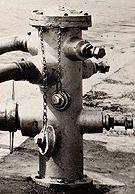| The Rick Company - Los Angeles, California |
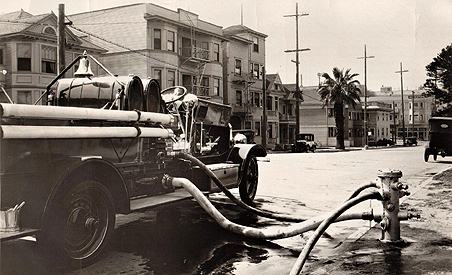 |
Water Bureau, Subject Files, A2001-021, 15/4 Hydrants, 1925-1926; and Allen McMillan
The Rick Super Hydrant The invention of the motorized triple combination pumper in the 1920s provided the fire service with a number of advantages. The operations of separately operated horse drawn hose reels or wagons, chemical wagons and pumping engines could be combined into one vehicle that could also carry a couple of ladders and other tools. All the personnel from the formerly separate companies could ride on this single piece of apparatus. Fire fighting at that time was done with straight tip nozzles, generally applied using 2½ inch hose lines. These nozzles would operate effectively at 50 psi nozzle pressure so oftentimes they were effective using hydrant pressure when the hose lays were short. A common fire fighting evolution of the time was for the first arriving engine to stop in front of the fire, pull off hose and lay a supply line to the nearest hydrant. The engineer would then have to pull off and separate his remaining supply line from the hose bed, attach it to the engine, hook the engine to the hydrant and then start pumping water. This sequence often led to critical delays in getting water delivered on the fire. Some departments started laying hose from the hydrant to the fire. A "plugman" would stay at the hydrant while the engine laid its supply line to the fire. Hose and equipment would be taken off the engine at the fire. As soon as one or more nozzles were connected to the hose, the plugman would charge the hydrant. This operation provided faster water delivery however due to friction loss in the supply line hydrant pressure was often inadequate to maintain effective fire streams, particularly if a wye was being used and the line was supplying two fire ground hose streams. To mitigate this problem the engine would double back to the hydrant and pump the hose lay. Originally the conversion from hydrant pressure to engine pressure required the hydrant to be shut down, the engineer and the plugman to quickly disconnect the hose from the hydrant and connect it to the engine discharge (assuming that it reached without having to add another section) and at the same time make a suction connection from the engine to the hydrant. This operation was time consuming, particularly if the hydrant was downhill from the fire and water wanting to drain back down the supply line made it difficult to uncouple and move the hose. Until the changeover was made, there would be no water at the fire ground from this particular hydrant. Asst. Chief Blake of the Los Angeles Fire Department reasoned that it would be more efficient to construct a valve that would allow water to be supplied directly to the fire from a hydrant, but where also an engine could be positioned to boost pressure without having to shut down the original water flow and reposition any hose lines. This device, known as the Blake 4-Way Valve, was widely used in the fire service. Asst. Chief Blake further correctly reasoned that being able to incorporate these same attributes into a fire hydrant would provide even greater efficiency. He designed the "Super Hydrant," manufactured by the Rick Company of Los Angeles, that had two chambers separated by a check valve. The Rick Super Hydrant could either be operated by conventional means, or it could be operated as a 4-way valve. The advantages of Chief Blake's design included:
The Rick Super Hydrant never truly caught on. The sales engineers didn't seem to fully understand and promote the significant advantages of this hydrant over conventional models of that time. With the advent of World War II engine company staffing was reduced so more engines were dispatched to fires in order to get sufficient personnel on scene. This allowed the first arriving engine to fight fire using water from its booster tank while a second engine established water supply. Eventually the advent of large diameter supply line made the use of a 4-way valve or Super Hydrant unnecessary in most communities. Regardless as to its lack of proliferation, the Rick Super Hydrant
remains one of the most innovative hydrant designs of the early 20th
century.
Capt. Willis Lamm, Water Supply Officer
|
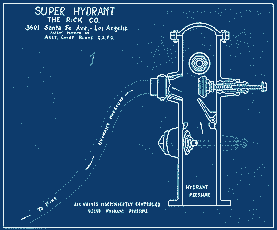 | "All valves independently controlled using hydrant pressure". |
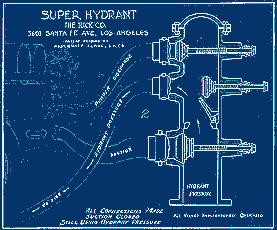 | "All connections made, suction closed, still using hydrant pressure". |
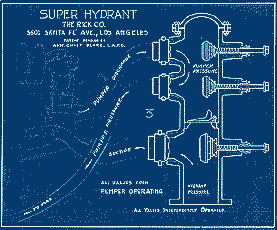 | "All valves open, pumper operating, all valves independently operating". |
|
Unless otherwise noted, all contents of these WWW pages © 1996-2002, FireHydrant.org |
